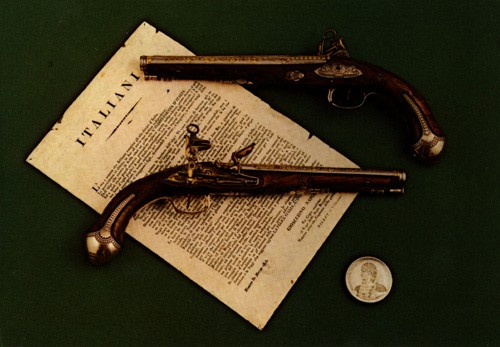During the Esposizione Emiliana of 1888, one exhibit, a 'temple to the Risorgimento', was so popular with the public that the council of the Comune decided to make it into a permanent museum, a museum which has been in effect inaugurated on the 12th June 1883 in a room in the Municipal Museum. As with other Risorgimento museums in Italy, the aim was twofold: first to inculcate patriotic ideals, particularly in the young, and second to encourage historical research on the recent past. A library and an archive were created to make documentary material available to students. In 1990, the museum was moved to a new site, the 'Casa Carducci', a small 16th century chapel rebuilt in the 18th century and, in the Napoleonic period, made into a private house.
The chronological limits for the museum were the fixed as 1796-1918 and the whole was divided into five large sections: the Napoleonic period; the Restoration; the Risorgimento; Italian unity; and Bologna at war.
The first section of the museum begins with a good deal of material on the First Italian Campaign. The entry of General Augereau with his troops into Bologna on 18th June 1796 constitutes an episode of fundamental importance for the history of the town. It was via these troops that the ideals of the Revolution were brought to the city, and the city was soon shaken to core by radical administrative and military restructuring. Various exhibits recount this event which so transformed Bolognese society, notably pamphlets dating from 1796-97 recording: the confiscation of church property; the constitution of the Cisalpine Republic; the diffusion of republican ideas; and the introduction of a new method of measuring time, known in Italy as 'French time'. There are prints showing the planting of Liberty trees and the destruction of aristocratic symbols. A proclamation by the Gonfalon of Bologna threatens punishment for all those who have not removed any coats of arms and other insignia from the fronts of their residences. Other pamphlets and engravings of about 1799 show allegorical representations of counter-revolutionary resistance.
The Napoleonic period is represented by the institution of the National Guard with its green, white and red flag. A standard of the Guard of Honour offered in 1805 by the town to Napoleon and a few statuettes of the Emperor complete this presentation. Of particular note is a fine collection of arms belonging to Murat, bequeathed to the town by Murat's sister Letizia, the wife of the Bolognese marquis Guido Taddeo Pepoli. It contains: a pair of double action hunting rifles and a flintlock pistol, all made by Boutet in 1804; a couple of pistols from the royal factory in Naples, offered to Murat on the occasion of his coronation in 1808; daggers; a scimitar used at Aboukir; epaulettes; braids and sword belts worn during the Russian campaign; and medals commemorating the taking of Capri and the creation of the Capodimonte observatory. Also of note in this section is a collection of Masonic objects and insignia from the beginning of the 19th century.
Karine Huguenaud


